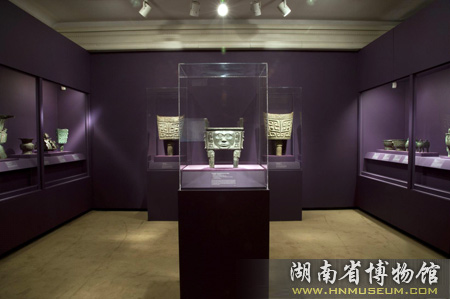- 中文
- EN
- Français
- 日本語
- 한국어
- 繁體中文
Along the Yangzi River: Regional Culture of the Bronze Age from Hunan
China Institute Gallery
125 East 65th Street, Manhattan
Through June 12

Sometimes you walk into exhibitions in the China Institute’s two small galleries and you can’t quite believe what you’re seeing: unfamiliar examples of ancient art of a kind and quality you would otherwise have to travel deep into China to find. And even there you would be hard-pressed to see work so lucidly presented, and with so generous an amount of supporting scholarship.
You get all of this in “Along the Yangzi River: Regional Culture of the Bronze Age From Hunan,” a display of 60 bronze ritual vessels from the collection of the Hunan Provincial Museum in Changsha. Chinese bronze casting dates back many thousands of years, and study of it has long focused on northern China. Recent archaeological work in the south, in the Yangtze River valley area in Hubei and Hunan, has broadened the focus, not only geographically but also stylistically, bringing to light dynamic and inventive regional variations on standard forms.
It’s true that most bronzes of the Shang and Zhou dynasties (circa 1600-256 B.C.), wherever they’re from, adhere to a set of common models. A tripod wine vessel called a jia, with flared mouth and pointed legs, is considered to be the earliest bronze found in Hunan thus far, though whether it was actually made there is a question: the vessel is identical to others produced in the north, and there’s no record confirming exactly where it was discovered.
Other pieces with standard forms have decorative features that do seem to be distinctive to the Yangtze valley, as in the case of a bell covered with raised, rough saw-tooth patterns. And at least one piece in the show, a rectangular ritual cooking vessel with large human faces in relief on all four sides, is not just Hunan-specific. It’s one of a kind, period. No other examples are known from anywhere.
It’s also enchanting to look at, which is the bottom-line attraction of everything here, objects rich in detail, from the assertions and delicacies of linear surface designs to almost impossible subtleties of color and tone in patinas. The exhibition catalog by the show’s organizers — Chen Jianming, director of the Hunan Provincial Museum; Jay Xu, director of the Asian Art Museum in San Francisco; and Fu Juliang, curator of bronze collections at the Hunan Provincial Museum — belongs in the library of anyone interested in Chinese art research. The exhibition itself, once seen, has a long shelf life in the mind.
Editor’s Notes:
“Along the Yangzi River: Regional Culture of the Bronze Age from Hunan”, co-hosted by Hunan Provincial Museum and China’s Institute Gallery, has evoked strong reactions among American audiences since its opening on February 1, 2011.
On June 3, a review article named “Along the Yangzi River” was published on “Art in View”,The New York Times by Holland Cotter.
Holland Cotter, the winner of 2009 Pulitzer Prize for criticism, is a famous art critic for The New York Times. He was well known for “his wide ranging reviews of art, from Manhattan to China, marked by acute observation, luminous writing and dramatic storytelling.”
In his article, Cotter speaks highly of the show, remarking that “The exhibition itself, once seen, has a long shelf life in the mind”, which is a great honor to both organizers and hosts of the exhibition.
This exhibition is the second cooperation between Hunan Provincial Museum and China’s Institute Gallery after “Nobel Tombs at Mawangdui: Art and Life of the Changsha Kingdom” in 2009.



